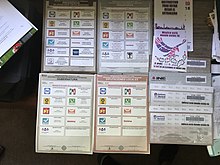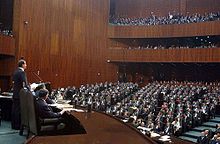Politics of Mexico
This article needs to be updated. (July 2023) |
This article needs additional citations for verification. (March 2019) |
Politics of Mexico Política de México | |
|---|---|
 | |
| Polity type | Federal presidential constitutional republic |
| Constitution | Constitution of Mexico |
| Legislative branch | |
| Name | Congress |
| Type | Bicameral |
| Meeting place | Legislative Palace of San Lázaro |
| Upper house | |
| Name | Senate of the Republic |
| Presiding officer | Ana Lilia Rivera, President of the Senate of the Republic |
| Lower house | |
| Name | Chamber of Deputies |
| Presiding officer | Marcela Guerra Castillo, President of the Chamber of Deputies |
| Executive branch | |
| Head of State and Government | |
| Title | President |
| Currently | Andrés Manuel López Obrador |
| Appointer | Direct popular vote |
| Cabinet | |
| Name | Cabinet of Mexico |
| Leader | President |
| Appointer | President |
| Headquarters | National Palace |
| Ministries | 19 |
| Judicial branch | |
| Supreme Court of Justice of the Nation | |
| Chief judge | Norma Lucía Piña Hernández |
| Federal Electoral Tribunal | |
| Chief judge | Felipe Alfredo Fuentes Barrera |
 |
|---|
|
|
The politics of Mexico function within a framework of a
The
Framework of twentieth-century politics
The
Under President
Throughout the second decade of the twentieth century, Mexico experienced political tension and rising economic instability.
In 1988, when
-
Logo of the National Revolutionary Party, 1929–1938
-
Logo of the Mexican Revolution Party, 1938–1946
-
Logo of the Institutional Revolutionary Party, 1946–
-
Logo of the National Action Party – the first opposition party to the PRI, 1939–
-
Logo for the leftistDemocratic Revolution Party, 1989–
Political parties

Constitutionally, political parties in Mexico must promote the participation of the people in the democratic life of the country, contribute in the representation of the nation and citizens, and be the access through which citizens can participate in public office, through whatever programs, principles and ideals they postulate.
- Institutional Revolutionary Party (Partido Revolucionario Institucional, PRI), founded in 1929;
- National Action Party (Partido Acción Nacional, PAN), founded in 1939;
- Party of the Democratic Revolution (Partido de la Revolución Democrática, PRD), founded in 1989;
- Labor Party (Partido del Trabajo, PT), founded in 1990;
- Green Ecological Party (Partido Verde Ecologista de México, PVEM), founded in 1986, but lost its registration for two consecutive elections; it has retained its registration since 1993;
- Citizens’ Movement (Movimiento Ciudadano, MC), founded in 1997;
- National Regeneration Movement(Morena), founded in 2012;
Political parties are allowed to form alliances or coalitions to nominate candidates for any particular election. The coalition must identify itself with a particular name and logo. Proportional representation (plurinominal) seats are assigned to the coalition based on the percentage of votes obtained in the elections, and then the coalition reassigns them to the constituent political parties. Once each party in the coalition has been assigned plurinominal seats, they do not necessarily continue to work as a coalition in government.
Throughout the 20th century, PRI had an almost hegemonic power at the state and federal level, which slowly began to recede in the late 1980s.[22] Even though since the 1940s, PAN had won a couple of seats in the Congress, and in 1947 the first presidential municipality (in Quiroga, Michoacán),[23] it wasn't until 1989, that the first non-PRI state governor was elected (in Baja California). It was in 1997, that PRI lost its absolute majority at the Congress of the Union. In 2000 the first non-PRI president since 1929 was elected in what was regarded as the cleanest Mexican election since the end of the Mexican Revolution in 1920.[24]
Major Political Parties

As of Recently, The politics of Mexico are dominated by four political parties:
Founded in 1929 as the Partido Nacional Revolucionario ("National Revolutionary Party"), the PRI has dominated Mexican politics for over 70 years bringing to power 11 different governments.
PAN was founded in 1939, but it did not win its first governorship until 1989; its candidates won the presidency in
The beginnings of the PRD go back to 1988 when dissident members of PRI decided to challenge the leadership and nominated Cuauhtémoc Cárdenas for president of Mexico. Cardenas lost in a highly contested election, but a new political party was born and the party emerged as a third force in Mexican politics, even though they have never captured the presidency.
MORENA grew out of a dispute between
According to a survey by the National Autonomous University of Mexico in 2017, 74 percent of Mexicans believe that Mexico's electoral system is not transparent and distrust official results. However, Freedom House shows that popular belief in free and fair elections has increased ever since.
Elections and political composition of the institutions
This article needs additional citations for verification. (March 2019) |

Suffrage is universal, free, secret and direct for all Mexican citizens 18 and older, and is compulsory (but not enforced).[25] The identity document in Mexico serves also as the voting card, so all citizens are automatically registered for all elections; that is, no pre-registration is necessary for every election. All elections are direct; that is, no electoral college is constituted for any of the elections at the federal, state or municipal level. Only when an incumbent president is absolutely absent (either through resignation, impeachment or death), the Congress of the Union constitutes itself acts as an electoral college to elect an interim president by absolute majority.

Presidential elections are scheduled every six years, except in the exceptional case of absolute absence of the president. However, the term of the current president,
A strongly ingrained concept in Mexican political life is "no reelection." The theory was implemented after Porfirio Díaz managed to monopolize the presidency for over 25 years. Presently, Mexican presidents are limited to a single six-year term, and no one who has held the office even on a caretaker basis is allowed to hold the office again. Deputies and senators were not allowed to immediately succeed themselves until 2018; both may now serve a maximum of 12 consecutive years.
Federal elections

2006
Federal presidential elections were held on July 2, 2006 concurrent with the full renovation of both chambers of the Congress of the Union. In these elections the
2012
In 2012, Mexico elected Enrique Peña Nieto as President.[29]
2018
In 2018, Mexico elected Andrés Manuel López Obrador as President.[30] He ran under a three-party coalition led by the leftist National Regeneration Movement (Morena) party he founded in 2014.[31]
State elections
The elections in each state are done at different times, depending on the state, and are not necessarily held at the same time with the federal elections. as of December 2023[32]
- PRI governs 3 states : Coahuila, Hidalgo, and Mexico
- PAN governs 8 states: Aguascalientes, Chihuahua, Durango, Guanajuato, , Querétaro, Quintana Roo, Tamaulipas and Yucatan
- PVEM governs a state: San Luis Potosi
- MC governs 2 states: Jalisco and Nuevo Leon
- Morena governs the remaining 18 states
Historical political development

The Mexican Revolution (1910 - 1920) was followed by the Great Depression, which led to a severely fragmented society and very weak institutions.[33] In 1929, all factions and generals of the Mexican Revolution were united into a single party, the National Revolutionary Party (NRP), with the aim of stabilizing the country and ending internal conflicts. During the following administrations, since 1928, many of the revolutionary ideals were put into effect, among them the free distribution of land to peasants and farmers, the nationalization of the oil companies, the birth and rapid growth of the Social Security Institute as well as that of Labor Unions, and the protection of national industries.
President Lázaro Cárdenas was fundamental to recover some of the social control that was lost during the Revolution and the following economic meltdown in the United States. However, Cárdenas was followed by a series of less-talented leaders that were unable to continue this path and establish an effective rule of law on Mexican society. Moreover, Cárdenas presidency happened before the UN focused on states as the rule in the 1940s and 1950s.[33]

The NRP was later renamed the Mexican Revolution Party and finally the Institutional Revolutionary Party. The social institutions created by the party itself provided it with the necessary strength to stay in power. In time, the system gradually became, as some political scientists have labeled it, an "electoral authoritarianism",[34] in that the party resorted to any means necessary, except that of the dissolution of the constitutional and electoral system itself, to remain in power. In fact, Mexico was considered a bastion of continued constitutional government in times where coup d'états and military dictatorships were the norm in Latin America, in that the institutions were renovated electorally, even if only in appearance and with little participation of the opposition parties at the local level.

The lack of the establishment of a true democracy in Mexico can be partially explained many factors, like the ones described above. However, one of them could also be the oil reserves that exist in the country and that were nationalized by the Cárdenas government. Several empirical studies point to a correlation between the existence of natural resources and the difficulty of turning into a democracy.[35]
The first cracks in the system, even though they were merely symbolic, were the 1970s reforms to the electoral system and the composition of the Congress of the Union which for the first time incorporated proportional representation seats allowing opposition parties to obtain seats, though limited in number, in the Chamber of Deputies. As minority parties became involved in the system, they gradually demanded more changes, and a full democratic representation. Even though in the 1960s, a couple (of more than two thousand) municipalities were governed by opposition parties, the first state government to be won by an opposition party was Baja California, in 1989.
Historically, there were important high-profile defections from the Institutional Revolutionary Party, like the ones of Juan Andreu Almazán (1940), Ezequiel Padilla (1946), Miguel Henríquez Guzmán (1952), and Cuahtémoc Cárdenas (1988), son of President Lázaro Cárdenas. These departures happened mainly because they opposed the presidential candidate nominations; however, only Cárdenas departure in 1988 resulted in the establishment of another political party (Party of the Democratic Revolution).[36]
The

Subsequent changes included the creation of the Federal Electoral Institute in the 1990s and the inclusion of proportional representation and first minority seats in the Senate. The
In the
Numerous electoral reforms implemented after 1989 aided in the opening of the Mexican political system, and opposition parties made historic gains in elections at all levels. Many of the current electoral concerns have shifted from outright fraud to campaign fairness issues. During 1995-96 the political parties negotiated constitutional amendments to address these issues. Implementing legislation included major points of consensus that had been worked out with the opposition parties. The thrust of the new laws has public financing predominate over private contributions to political parties, tighter procedures for auditing the political parties, and strengthening the authority and independence of electoral institutions. The court system also was given greatly expanded authority to hear civil rights cases on electoral matters brought by individuals or groups. In short, the extensive reform efforts have "leveled the playing field" for the parties.
The 2006 elections saw the PRI fall to third place behind both the PAN and the PRD. Roberto Madrazo, the presidential candidate, polled only 22.3 percent of the vote, and the party ended up with only 121 seats in the Chamber of Deputies, a loss of more than half of what the party had obtained in 2003, and 38 seats in the Senate, a loss of 22 seats. Felipe Calderón, a conservative former energy minister, won a narrow victory, and he was elected as the new president. Andrés Manuel López Obrador, lost the very tight race, did not accept the result.[37]
In the 2012 elections, Enrique Peña Nieto was elected as the president of Mexico, meaning the return of PRI after 12 years out of power.[29]
On 1 December 2018,
See also
- State governments of Mexico
- Federal government of Mexico
- Powers of the Union (Mexico)
- Law of Mexico
- History of democracy in Mexico
References and notes
- ISBN 978-92-64-01832-7.
- ^ Duncan, Raymond. "The Mexican Constitution OF 1917 compared with the Constitution of 1857" in American Academy of Political and Social Science. Philadelphia: 1917, p. 8–122.
- ^ Ai Camp, Roderic. "Democratizing Mexican Politics, 1982–2012" in Oxford Research Encyclopedia. Claremont: 2015, p. 1.
- ^ "Revolt against Carranza, His Death, and Obregón's 1920 Presidential Campaign". Library of Congress. Retrieved March 6, 2023.
- ^ "Plutarco Elias Calles". Retrieved March 6, 2023.
- ^ "Álvaro Obregón: así fue el asesinato del caudillo". El Financiero (in Spanish). 17 July 2018. Retrieved March 9, 2023.
- ^ "El Nacional Revolucionario, 9 de junio de 1929". El Nacional Revolucionario (in Spanish). Retrieved March 9, 2023.
- ^ a b Raby, David. "Mexican Political and Social Development since 1920" in Canadian Association of Latin American and Caribbean Studies. Toronto: 1976, p. 27.
- ^ "Del Partido de grupo al partido de masas: La transformación del PNR al PRM". Gobierno de Mexico (in Spanish). Retrieved March 10, 2023.
- ^ "El PNR se convierte en el Partido de la Revolución Mexicana". Memoria Politica de Mexico (in Spanish). Retrieved March 10, 2023.
- ^ Schmidt, Samuel. "Politics and Government: 1946–1996" in Encyclopedia of Mexico. Chicago: Fitzroy Dearborn 1997, p. 1121–1127.
- ^ Brachet-Márquez, Viviane. "Politics and Government: 1910–1946" in Encyclopedia of Mexico. Chicago: Fitzroy Dearborn 1997, pp. 1118–1121.
- ^ Rippy, Merrill. "The Nationalized Oil Industry of Mexico: 1938–55". Chicago: The Southwestern Social Science Quarterly 1957, pp. 6–18.
- ^ Dell, Melissa. "Path dependence in development: Evidence from the Mexican Revolution". Boston: Harvard University Press 2012, pp. 1–37.
- ^ "Mexico, October 2, 1968 – The Tlatelolco Massacre". 1968: A Global Year of Student Driven Change – UCSB Department of Black Studies. Retrieved March 10, 2023.
- ^ a b c Ai Camp, Roderic. Democratizing Mexican Politics, 1982–2012. Oxford University Press: 2015
- ^ "Ruling Party and Tradition Under Attack : Mexico's Campaign Goes Topsy-Turvy". Los Angeles Times. Retrieved March 10, 2023.
- ^ Schmidt, "Politics and Government, 1946–1996", p. 1126.
- ^ Bruhn, Kathleen. Taking on Goliath: The Emergence of a New Left Party and the Struggle for Democracy in Mexico. Penn State University Press 2004
- ^ Uges, Antonio, "Citizens' Views on Electoral Governance in Mexico accessed 6 March 2020
- ^ "Article 41, Political Constitution of the United Mexican States". Archived from the original on 2007-09-28. Retrieved 2007-03-07.
- ISBN 978-0892064571.
- ^ Efemérides del PAN
- ^ Duncan, Raymond. "Mexico's Democratic Transition: The Search for New Reform Coalitions" in Law and Business Reviews of the Americas. Mexico: 2003, p. 283.
- ^ Adrian Joaquin Miranda Camarena (November 5, 2013). "El Sufragio en Mexico: Su obligatorierdad" [Cumpulsory Voting in Mexico] (PDF). Biblioteca Jurídica Virtual del Instituto de Investigaciones Jurídicas de la UNAM (in Spanish). Retrieved July 19, 2019.
- ^ a b Juan Carlos Gutiérrez (July 3, 2018). "El periodo de gobierno de López Obrador durará 2 meses menos" [Lpez Obrador's presidency will last two fewer months]. Milenio (in Spanish). Mexico City.
- ^ "BC cambiará el periodo para gobernar en 2019" [BC to change the term for governor in 2019]. Diario de Mexico (in Spanish). June 10, 2018. Retrieved July 19, 2019.
- ISBN 9780804771610.
- ^ a b City, Associated Press in Mexico (2 December 2012). "Enrique Peña Nieto takes office as Mexico's president". the Guardian.
- ^ https://fas.org/sgp/crs/row/IF10867.pdf [bare URL PDF]
- ^ "Who is Mexico's Andrés Manuel López Obrador?". BBC News. 29 November 2018.
- ^ Digital, Tiempo-La Noticia. "Así quedan las 32 gubernaturas tras las elecciones (MAPA)". tiempo.com.mx (in European Spanish). Retrieved 2021-12-24.
- ^ )
- ^ Using the phrase of Schedler A (2004) From Electoral Authoritarianism to Democratic Consolidation" in Mexico's Democracy at Work, Crandall R, Paz G, Roett R (editors), Lyenne Reinner Publisher, Colorado USA
- ^ Clark, William Roberts, Matt Golder, and Sona N. Golder. 2013. “Power and politics: insights from an exit, voice, and loyalty game.” Unpublished manuscript, University of Michigan and Pennsylvania State University.
- OCLC 772633021.
- ^ McKinley, James C. Jr.; Thompson, Ginger (6 July 2006). "Calderón Wins Narrow Victory in Mexico Election". The New York Times.
- ^ "Mexico's López Obrador sworn in as first leftist president in decades". BBC News. 2 December 2018.
- ^ Karol Suarez, Rafael Romo and Joshua Berlinger. "Mexico's President loses grip on power in midterm elections marred by violence". CNN.
Further reading
- Bruhn, Kathleen. Taking on Goliath. Penn State University Press 2004. ISBN 978-0271025117






